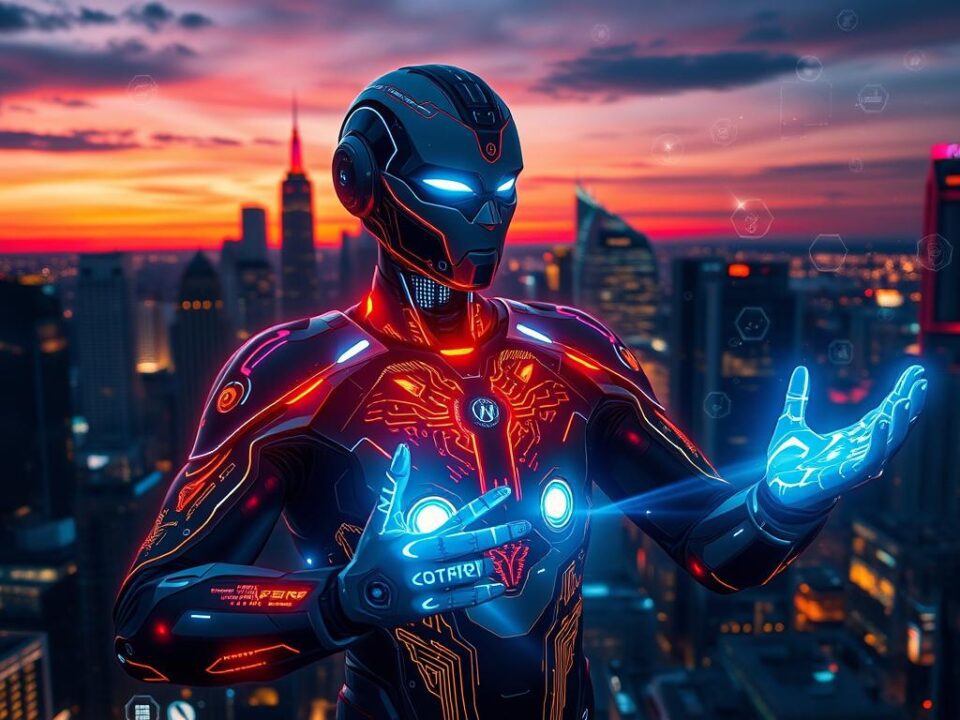Law enforcement agencies are looking for new ways to fight crime. Riley, an advanced AI system, is leading the way. This AI detective is not just a helper; it’s a game-changer in solving crimes.
Riley uses big data and pattern recognition to give detectives valuable insights. This AI helps fill the gaps left by old methods. It makes it easier for police to handle tough cases.
Introduction to AI Police Detectives
AI police detectives are changing how law enforcement works. They use artificial intelligence to help solve crimes. This technology looks at lots of data, which is hard to do by hand.
By using AI, police can do their jobs better and faster. This makes solving crimes more efficient.
What is an AI Police Detective?
An AI police detective is a tool that helps with investigations. It looks at digital evidence quickly. This is very helpful because time is important in solving crimes.
Tools like Veritone Investigate help manage digital evidence. This lets officers focus on solving cases, not just finding data.
How AI Enhances Crime Solving
AI helps police analyze big data sets. This makes solving crimes faster and more accurate. For example, Veritone Illuminate makes it easier to search through evidence.
AI can look at images, listen to conversations, and find connections between crimes. This helps police see things they might miss otherwise.
The Rise of AI in Law Enforcement
People want police to be open and trustworthy. AI helps with this by making police work more transparent. Sixty-one percent of people trust police to use technology to find suspects.
Tools like facial recognition cameras and AI for crime mapping help identify suspects. As criminals get smarter, AI becomes more important for keeping everyone safe.
Meet Riley: Your AI Crime-Solving Partner
Riley AI is a game-changer in law enforcement. It’s an AI designed to make investigations better. With advanced tech, Riley helps solve tough cases faster. Let’s explore Riley’s background, how it was made, and its cool features that help officers solve crimes.
Background and Development of Riley
Riley AI came from a team-up between tech gurus and cops. They saw the need for better tools to fight crime. They worked hard to make an AI that can analyze lots of data and find important clues.
This effort led to Riley, an AI that thinks like a top detective. But it can do more because of its tech smarts.
Key Features of Riley
Riley AI brings new levels to crime solving. It has some key features:
- Crime scene analysis: Riley quickly checks evidence from crime scenes. It helps teams spot important details they might miss.
- Suspect identification: Riley uses smart algorithms to create profiles. It narrows down suspects based on data.
- Ongoing learning: Riley gets better with time. It learns from cops, keeping up with new ways to solve crimes.
With these features, Riley AI helps cops do their job better. It’s all about making sure justice is done.
How AI Detectives Work
AI detectives use advanced systems to gather and analyze data on crimes. They are effective because of two main steps: collecting and analyzing data, and using machine learning to spot patterns in big data.
Data Collection and Analysis
AI technology is great at data analysis. It helps law enforcement gather and understand information from many sources. This includes:
- Crime reports and patterns
- Social media interactions
- Surveillance footage
- Digital evidence from cybercrime incidents
The global crime analytics market is expected to hit $12.6 billion by 2027. This makes collecting and analyzing data more important than ever. AI detectives use this information to find crime hotspots and use resources wisely.
Machine Learning and Pattern Recognition
The heart of AI detectives is machine learning in policing. It lets them find trends and predict crimes by looking at past data. For example, PredPol has cut crime by up to 25% with predictive analytics. The algorithms behind these systems use:
- Pattern recognition in crime statistics
- Data mining to find hidden connections
- Learning from new data to get better
By combining advanced algorithms with lots of data, AI detectives can get better at predicting crimes. This helps law enforcement prevent crimes more effectively, keeping communities safer.
The Benefits of AI in Policing
Artificial intelligence in law enforcement offers many advantages. It makes operations better and helps officers do their jobs well. AI makes solving crimes faster and more effective.
Improved Efficiency and Speed
AI can handle huge amounts of data quickly. This means police can act fast when crimes happen. They can also look at crime data right away and find useful information.
AI can guess where crimes might happen. This helps police send more officers to those places. It also helps plan shifts based on how busy they’ll be.
Enhanced Accuracy in Crime Solving
AI uses machine learning to make crime analysis better. It finds patterns in old data that humans might miss. This helps spot threats before they happen.
AI can also look at body-worn camera footage. It helps find misconduct or important events. This leads to better investigations and keeps the public safe.
Cost-Effectiveness for Law Enforcement
Using AI can save police departments a lot of money. AI does tasks like making reports, so police can focus on other important things. This makes crime prevention better and keeps everyone safer.
Real-World Applications of AI Detectives
AI technology has changed law enforcement for the better. It shows how AI can solve cases. This is seen in many areas where AI helps police a lot.
Looking at these examples, we see how AI detectives work well. They make investigations better and more effective.
Successful Case Studies Involving AI
The Miami Police Department used AI for facial recognition and social media checks. Before AI, they solved 45% of murders. But after using AI, they solved 68% of murders.
“Detectives using AI have a 66% greater chance of finding suspects in violent crimes.”
This shows AI’s power in solving tough cases. The Department of Justice is working on AI ethics. This shows how important it is to use AI wisely.
Collaborations with Police Departments
Police and tech companies working together is key. AI tools like NEXYTE have helped find more illegal goods by 155%. This shows AI’s impact on crime prevention and safety.
AI success stories show its value in helping police. As technology advances, police are looking for new ways to use AI. They want to mix human skills with AI’s power.
Addressing Concerns: Ethics and AI
Law enforcement is using more AI technology, raising big questions about ethics. The good AI can do in policing must be weighed against privacy and transparency. If AI is used wrongly or unfairly, it could harm communities a lot.
Privacy Issues Surrounding AI Technology
AI can handle a lot of data, which makes privacy a big worry. A smartphone can hold thousands of data points, affecting our privacy a lot. For example, Robert Williams was wrongly identified by facial recognition, showing the dangers.
Racial biases have been found in AI that predicts who might commit crimes again. This makes privacy concerns even bigger and calls for quick action on ethics.
Transparency in AI Decision-Making
It’s key for law enforcement and communities to trust each other. Making AI fairer is a big step towards this trust. Groups like the AI Now Institute want to stop using facial recognition until it’s fair.
Having clear rules and understanding how AI works is important. This ensures AI is used right in investigations.
Training and Integration of AI Detectives
AI is changing law enforcement, and training police on AI is key. It helps officers use AI tools for officers well. This training boosts crime-solving and makes officers comfortable with new methods.
Training Law Enforcement on AI Tools
Law enforcement needs good training to use new tech. Training covers:
- How AI systems work and their role in solving crimes.
- Using AI to make work easier and more efficient.
- Practicing with AI software in real cases to improve skills.
- Using AI to make better decisions during investigations.
Integrating AI Detectives into Existing Systems
Integrating AI into law enforcement is crucial. It helps departments get better without losing what they have. Important steps include:
- Making sure old systems work with new AI, so data moves easily.
- Creating rules for using AI in daily work.
- Keeping training up to date for officers.
- Sharing knowledge between departments to learn from each other.
The Future of AI in Policing
The world of law enforcement is changing fast with AI. Agencies are dealing with not enough staff and more crime. They need new technologies to solve cases better and faster.
Emerging Technologies in Crime Detection
New tech is changing how police work. For example, body-worn cameras are becoming key. Researchers at Stanford are looking into how to analyze lots of footage.
Studies show that the first 45 words an officer says can tell if a stop will go well. This shows how important real-time data is.
Predictions for AI’s Role in Law Enforcement
Crime detection systems are going to be more important. Predictive analytics can spot bias crimes quickly, not weeks later. This is crucial for police who are short-staffed.
Regional Technology and Crime Centers (RTCCs) will play a big role in using tech to help police. As AI in policing grows, keeping operations safe from cyber threats is key. This includes fighting off ransomware and AI-powered crimes.
Case Scenarios with Riley in Action
Looking at how Riley works in real cases shows the big role AI plays in police work. It helps solve murders and find cybercrimes by analyzing data. This shows how tech can make investigations better.
Solving Homicides with AI Insights
Riley’s tools are key in solving tough murder cases. It looks at lots of data to find patterns and links that humans might miss. This helps solve murders faster, making police work more efficient.
Using AI in murder cases changes how crimes are solved. It lets police act quicker to stop violence.
Uncovering Cybercrime through Data Analysis
Cybercrime is a big problem today. Riley is great at finding cyber threats by looking at lots of data. It spots odd activities that might be criminal, helping police fight cybercrime.
With Riley’s help, police can act fast against cyber threats. This shows how important AI is in fighting cybercrime.
User Experience: Interacting with Riley
Law enforcement officers now work with Riley, a big step in policing tech. They use Riley’s advanced features to make investigations smoother. This helps them focus on important decisions, not just sorting data.
How Officers Work with Riley
Officers use Riley through easy-to-use interfaces made for them. Riley’s real-time data and AI help them during investigations. Key parts of this include:
- Real-time data analysis for quick decisions.
- Predictive analytics to spot criminal patterns early.
- Tools for team communication during investigations.
Feedback from Law Enforcement Teams
Law enforcement teams share valuable feedback on working with AI detectives like Riley. They like how fast and accurate AI tools are. But they also suggest improvements, such as:
- More training to use AI features well.
- Easier-to-use interfaces for everyone.
- Keeping a human touch in decision-making.
This feedback helps make AI tools better for police work. It guides future improvements in law enforcement tech.
The Role of Human Officers Alongside AI
AI technology has changed how police prevent and solve crimes. With AI tools like Riley, human officers are still key. Together, they make policing better and more effective.
Collaboration Between Humans and AI Detectives
Working together, human officers and AI detectives make investigations better. AI looks at big data to find patterns and predict crimes. Humans use their skills to make sure decisions are fair and right.
This teamwork leads to:
- Strategic resource allocation: Police use data to plan better.
- Proactive crime prevention: AI spots crime areas early, helping prevent more.
- Enhanced community safety: AI helps find suspects fast.
Importance of Human Oversight in Investigations
AI helps a lot, but humans must check its work. They make sure decisions are fair and just. This mix of AI and human judgment builds trust in the police.
Good oversight means:
- Checking for bias and ensuring fairness.
- Telling the public how AI is used.
- Training officers for AI’s challenges.
In the future, humans and AI will work even better together. This will make communities safer and more trusting of the police.
Conclusion: Transforming Crime Fighting with AI
Artificial intelligence is changing policing in big ways. Projects like Humberside Police’s trial show AI can save time in emergency calls. It also improves facial recognition, making crime detection more accurate.
These advancements mean safer communities and better use of resources. AI is making policing more efficient and effective.
Final Thoughts on AI in Law Enforcement
Technology is shaping the future of policing. Agencies must embrace these changes. The University of Chicago’s crime prediction algorithm shows AI’s power.
But, we must also think about ethics. We need to avoid biased data and ensure accountability. Transparency and teamwork are key to using AI wisely.
Encouraging Adoption of AI in Policing
More AI in policing means solving crimes faster. It helps officers serve communities better. By using data and algorithms, trust can grow between law enforcement and the public.
It’s important to keep talking about ethics and innovation. This will shape AI’s role in policing for the future.







